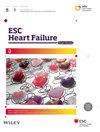Identification of hub genes for the diagnosis associated with heart failure using multiple cell death patterns
Abstract
Aims
Heart failure (HF) is an important public health problem worldwide, and programmed cell death (PCD) plays a crucial role in its pathologic process. This study aims to identify the hub genes associated with HF through PCD in order to better understand the pathogenesis of HF and improve its diagnosis and treatment.
Methods and results
The gene expression dataset of HF was obtained from the GEO database. Bioinformatics and machine learning algorithms were utilized to screen the HF key genes and PCD-related HF hub genes, and an HF diagnostic model was constructed on this. Functional enrichment analysis clarified the gene ontology and signalling pathways of HF. The immune infiltration analysis of HF was performed to explore the expression levels of immune cells in each hub gene. Through bioinformatics analysis, 95 HF key genes were obtained. Functional enrichment analysis showed that they were mainly involved in inflammation, immunomodulation and other mechanisms. DHRS11 and LRKK2 were identified as PCD-associated HF hub genes by machine learning algorithms. The hub genes were confirmed as significant biomarkers of HF in the training and validation datasets, and their constructed nomogram had effective diagnostic value. Immune infiltration analysis showed significant immune imbalance of T-cell populations, monocytes and macrophages M2 in HF.
Conclusions
In this study, DHRS11 and LRKK2 were identified as hub genes. HF diagnostic model construction and immune infiltration analyses were performed, which provided new ideas for the molecular mechanisms of HF development and treatment.


 求助内容:
求助内容: 应助结果提醒方式:
应助结果提醒方式:


